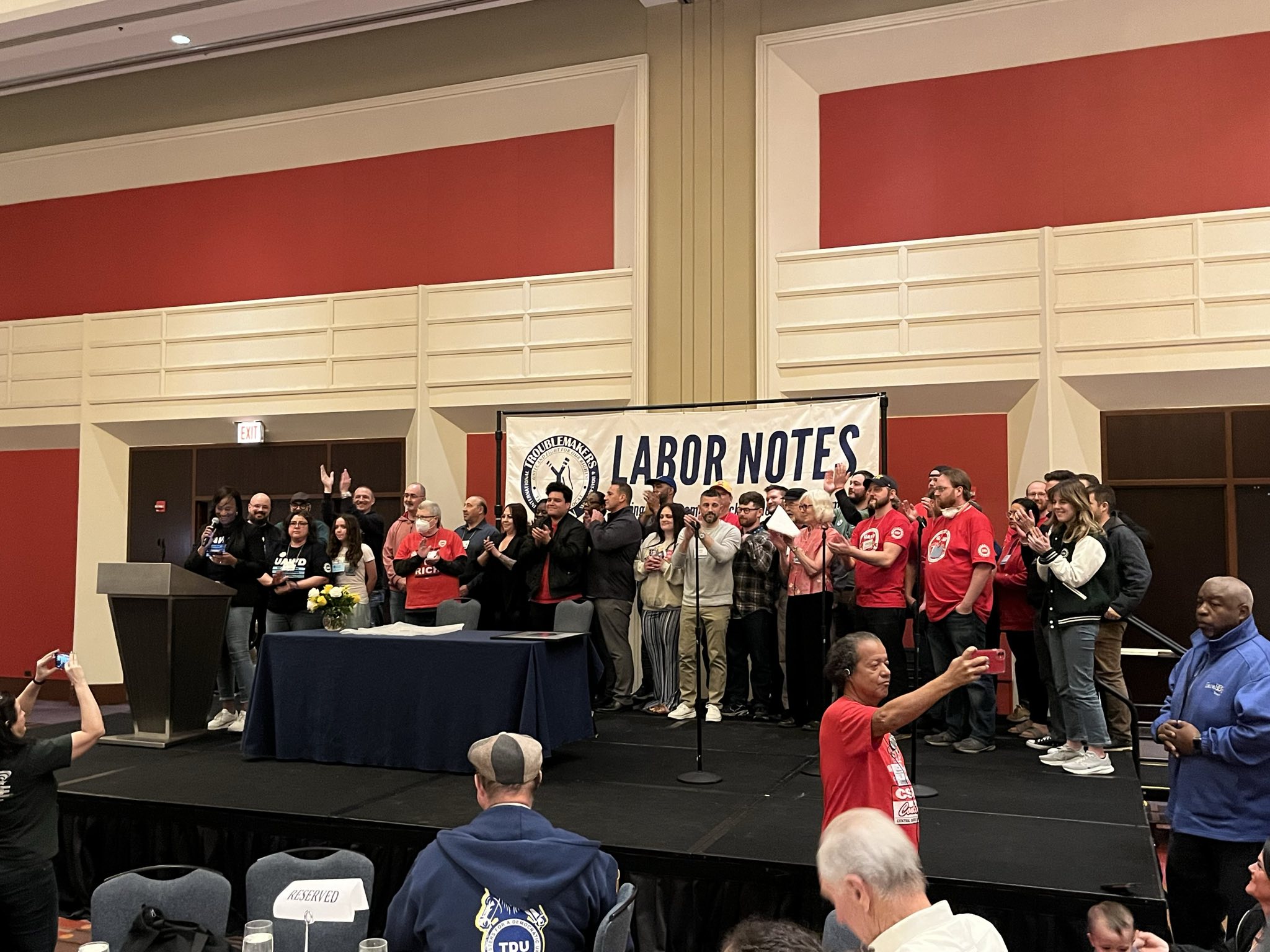Since the start of COVID-19, workers have coupled innovative new organizing models with traditional “ground game” to gain incredible wins at worksites around the world. These have ranged from Amazon to Trader Joe’s in the United States, Indigo Chapters Bookstores to Second City (AICE Union) in Canada, and of course the historic farmers strike in India. Each of these campaigns amplified their voices through the use of social media platforms like TikTok, Instagram and, YouTube. These workers also had something else on their side—a captive audience. While they were organizing, many others, who spent quarantine in lockdown were gripped by images of these workers’ struggles. Workers fought for basic protections for health, safety and respect, but also won wage increases.
In Canada, fifty thousand education workers united in what was deemed as a illegal strike, and galvanized public support. The slogan “39K is not enough,” a reference to their wages, started trending online. In response, the Conservative government did what they do best—attacked ordinary people. They attempted to fine striking workers $4,000 a day. This only garnered greater support for the workers. As a result, one of the largest public sector unions representing education workers began calling for an indefinite general strike. Other major unions from across the country started sending strike support funds and people power. Overnight, the government retracted from their position and came back to the bargaining table. This moment showed that, when given the opportunity, people across Canada are motivated and ready to fight.
Despite the recent, high-profile actions, why are we not seeing more unions or the “left” party (New Democratic Party or NDP), taking full advantage of this moment of strong public support of labor as they would have in the past?[1] As a whole, it feels like the labor movement in Canada and the NDP have taken a haitus and are not taking advantage of the traditional labor tools and tactics. Joe Burns, in his book, Class Struggle Unionism, argues that this is due to the struggle happening within the unions themselves. Much like their American counterparts, the Canadian labor movement is dominated by business unionism, which Burns defines as bargaining for only monetary items. In this arrangement, unions see themselves as “business agents” representing their members. Business unionism accepts that there must be compromises with bosses and avoids conflict at all costs. This form of unionism is antagonistic to anything seen as rocking the boat, and is predicated on working within the legal system. Adherents to business unionism would never engage in the tactic the striking Educators did in Ontario, and they would never see the gains those Educators won either.
There is growing talk amongst Canadian workers about how to break out of this business unionism malaise. Much of this conversation is due to seeing successful organizing campaigns in the US. Yet, despite similar cultural norms, Canadian workers are not seeing the same gains. Why is this?
We know that organizing is different from advocacy and mobilizing because it is structure led, it requires mass participation from workers, and is defined by ordinary people transforming their own lives. Organizing requires time and dedication to building relationships, and bringing new people into our movement. It is about talking to every single person, even the people who on the surface level don’t seem to agree with us. It flips the individualism and isolation prevalent in our society on it’s head. Yet, in this current moment, across Canada, there seems to be a lack of political will to organize our unions and communities. This must be addressed head on.
This struggle to organize is happening as the right is gaining political influence and power across many provinces. Throughout this pandemic, right-wing groups have gained followings by tapping into people’s rage, attacking the “elites,” and portraying themselves as fighters for the common people. This is why we have seen the rise of the new right wing Peoples Party of Canada and the “Freedom Convoy,” both of which formed early in the pandemic in opposition to vaccine mandates. Theses groups called for, and engaged in direct actions at international border crossings, occupied the streets of Ottawa, and harassed people during the quarantine and lockdown on a daily basis. They are the Canadian iteration of the January 6ers in the US and have grown more sophisticated than their American counterparts. Understandably, peoples’ growing discontent with the cost of living, the war in the Ukraine, inflation, and the ongoing health crisis has pushed many to seek alternative answers. With their fascile analysis broadcasting loudly across social media—and increasingly mainstream media—many people are being drawn into groups on the right, which can no longer be called fringe. By all accounts, the reactionary right is now rising across Canada.

In the the shadow of this rising right, it seems the labor movement and the left at large are not organizing new people, and are, in fact, hemorrhaging members. While the left remains static, the right has reinvented and morphed itself to appeal to diverse groups of people across the country. From conspiracy theorists and reactionary new immigrants, to anti-statist liberatarians, and even open fascists, the new right has welcomed each of these groups. This ascendant right is a fragmented but growing movement that will define the next decade of Canadian politics. Therefore, it is our duty to understand their rise and counter them.
Poilievre’s as the Anti “Elite” Champion
In September, Pierre Poilievre became the Leader of the Conservative Party of Canada. Poilievre is a right wing populist who gained celebrity status for his support of the Freedom Convoy. The convoy disrupted and occupied Ottawa for weeks during an era of strict COVID lockdown. Many Canadians frusturated with cost of living and dealing with COVID fatigue supported the convoy. Poilievre gained popularity by positioning himself as anti-Trudeau, anti-elite, and for “the people” messenger. His rhetoric, like most right-wing populists, is full of lies and emotive language that makes him appear to champion the “little guy.”
The danger of leaders like Poilievre is that they tap into to people’s collective rage. The left in Canada, as an excuse for its failure to build engagement, has prescribed the populous as apathetic. Poilievre exposes this fallacy, by showcasing people are not apathetic, they are enraged, and he in turn channels their rage into right wing politics. Clearly, people in Canada believe the status quo is untenable. Poilievre is as deceptive as Donald Trump, making people believe that he is a champion of workers and the average person. When we look at his political career since 16, there is ample evidence to believe his entire ideology is predicated on destroying workers rights, unions, and the social safety net. He believes that the rich should not pay taxes and believes that the Bank of Canada should be abolished. Yet, despite these assaults on working people, he has retained his mystique of working for common people. This failure to disrobe him of this label is as much the fault of the media as it is the left.
Today, the inability of Canadian unions and the left to inspire the working class to commit to fighting bosses and billionaires, has created a vacuum that the right, led by Poilievre, is filling. Despite this, there is still hope. In Canada, unions need to commit to putting more money and investment into internal and external organizing, they need to look at the tactics and tools of the right and do them better. Workers are desperate for an actual response that challenges oligarchs and their monopolies irrespective of partisan politics. Today, the right is growing in Canada and giving responses that appeal to many because the longstanding issues of inflation, poverty, and the global pandemic. If we continue to let the right out-organize the left, workers will be devasted with the cuts to healthcare, education, pension and unemployment insurance. We must do better.
So, What are the Tactics of This New Right?
Media as Organizing Tool
The right wing groups have grown much of their base through alternative news outlets and disseminating their own propaganda. Across the country, pseudo-journalists have set up channels, pages, Tik Toks and Instagrams. They present alternative ideas and solutions through savvy rhetoric, humor, and charisma. These leaders have tens of thousands of social media followers.
This use of digital tools should not go unnoticed. As the left, we need to stop limiting our imagination when it comes to media. Alternative media spaces create a place to build community. These sites can help resolve people’s general feeling of malaise and alienation. There is a reason why the Freedom Convoy was successful, because streamers called for the occupation of Ottawa, and people showed up. We should not discount this. This specifically is something the left needs to understand. If utiltized correctly, the value of these platforms are clear. They can provide access to communities, and solidarity. The pandemic led to increase use of apps and technology, helping people remain connected across the world. We need to be where they are, and communicate in these disparate mediums. The left needs to capture the interest of working people and use media as a tool to pull people into a workers movement.
We need more creative alternative media, as opposed to a heavy reliance on traditional op-eds and legacy media. To do so, we must put money into platforms made by identified community leaders and activists. We have to stop being contrived, “playing nice,” and acting afraid in our communications. One should look to Amazon Labor Union, Dripped Out Trade Unionists, or even RMT’s President Mike Lynch for inspiration. These leaders are a savvy online, grab attention and are making unions look like the fighters and champions of the working class. They illustrate through digital tools their losses and wins, keeping people engaged, educated, and believing that change is possible. We should support organic leaders and not be afraid to let them lead and engage with people how they see fit. The media is a powerful tool, and right now the left is not utilizing it properly. Only by expanding our media horizons, will the left grow out of this daze that we are stuck in. Of course, social media tools can never supplement bread and butter on the ground organizing, but it is a complement to face-to-face organizing. If we properly utilize the tools of new media, it will enhance every other form of organizing we are engaging in.
Direct Action as a Tactic
The Freedom Convoy direct action came about after months of small organized protests. These groups were confrontational, bullying, and aggressive. The lack of response from both the left, and the police, only emboldened them to hold more rallies and grow their own alternative communities. This growth has seized on the anger and frustration present in diverse communities across Canada. By engaging these communities, the right has grown its movement to look more representative of Canadian society. These direct actions have shined a light on problems in society, albeit offering the opposite of solutions.
The survival of the left is incumbent on returning to direct action. People have lost interest in the left because our response always begins with compromise. As the right has shown, people are angry. Taking to the streets, protesting, and strikes tackling these injustices are a pathway to growing our movement. But, in fear of looking like the rightwing of the last two years, we no longer do so. Instead, when they go to the streets, we remain on the sidelines. We have to stop directing people through long, drawn out legal and political processes that are designed to see average people disenfranchised and get back to our roots. We must engage with direct action if we are to win.
Developing Leadership as a Foundation
We need leaders that fight, and that are organic in their communities and workplaces. Unfortunately, that is not what the left is doing right now. In fact, there is no leadership development. Instead, there is hand selecting of people utilizing a quasi-NGO model of people who advocate for a community, rather than actually engage the community. This often falls down the slippery slope into tokenism. We continue to resort to advocacy and saviourism, that selects someone who isn’t threatening to the bosses or the “elites”. It’s constantly about working within the capitalist system and compromising. The left has created an alienated political class filled with leaders who were selected for the worst forms of identity politics reasons. While the right also engages in tokenism and butchered identity politics, it is incumbent on the left to engage in true intersectional politics, identify and support leaders with a class analysis along with a racial analysis. It is a cop out to say that there are no emerging political leaders on the left in Canada, what is more true is there are not emerging political leaders on the left in Canada who are supported by institutional forces. We must rectify this.
As the right has built community through the media, and has a new crop of stars who are viewed as the leaders, the left must also learn to trust its own organic leaders. We cannot allow skepticism of youth or alternative tactics to stymie our progess. People across the world are looking for strong leaders, to respond to crises. They want people who challenge the status quo and provide alternative solutions. This should be the opening the left has always wanted. Yet, today, the right remains at the forefront of this movement. We must combat this and overcome this.
Conclusion
It is important for us to not become jaded as organizers and activists. Too many have become sucked into pessimism and lack hope for something greater. But we should have hope. These tactics are actually better suited to an inclusive, multiracial, working class movement and party. It is incumbent on us to recognize and realize this. In no world should the right be viewed as the space for direct action. In no world should alternative media, with its long left-wing history, be solely a conduit for the right. And in no world should there be no emerging multiracial working class left-wing leaders. We can look around the world for inspiration from workers strikes, protests and left leadership.
The misattributed malaise that has been prescribed on Canadians is clearly false. People are angry, people are looking for answers. We know that the right-wing answers will never actually bring about the change that people are seeking and will actually fracture into greater discontent and schisms. We know that fake populists like Pierre Poillevre and other Conservatives actually loathe the poor and working class, and will expose themselves over and over again. We should, however, use this moment as organizers and activists to learn and evolve. We must learn from the right’s recent engagement with these tactics and build the better world that we need. It’s ok to say we aren’t perfect, it’s ok to say we can do better. We must utilize alternative and traditional media equally to highlight our fighting nature, we must engage in direct action and not back down from fights, and we must support and follow a new crop of organic leaders into a better Canadian future. We have the answers, we know how to do this, we have done it before. It is now on us as the left to do the work.
[1] It is important to mention, we have seen spurts of organizing, where grassroots defence groups like Najuawan Support Network, a student/worker led organizing efforts fighting wage theft and exploitation of International Students. It is important to mention, the ongoing Indigenous resistance history of defending water and land continues across Canada. Yet both of thse examples fall outside the purview of traditional labor in Canada.
Aminah Sheikh is a union organizer and a Research Associate at the Canadian Centre for Policy Alternatives.



